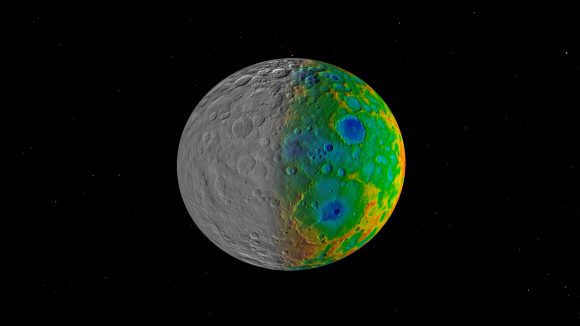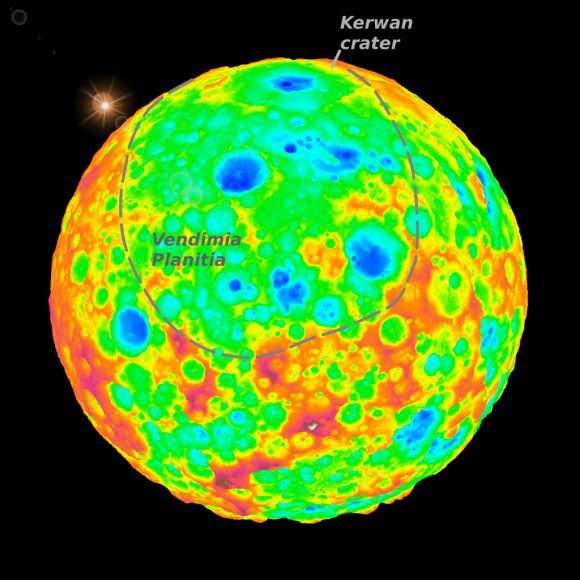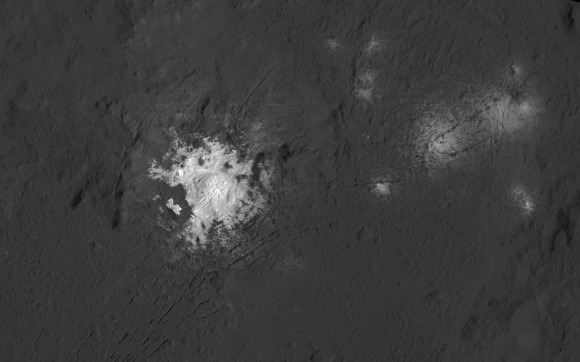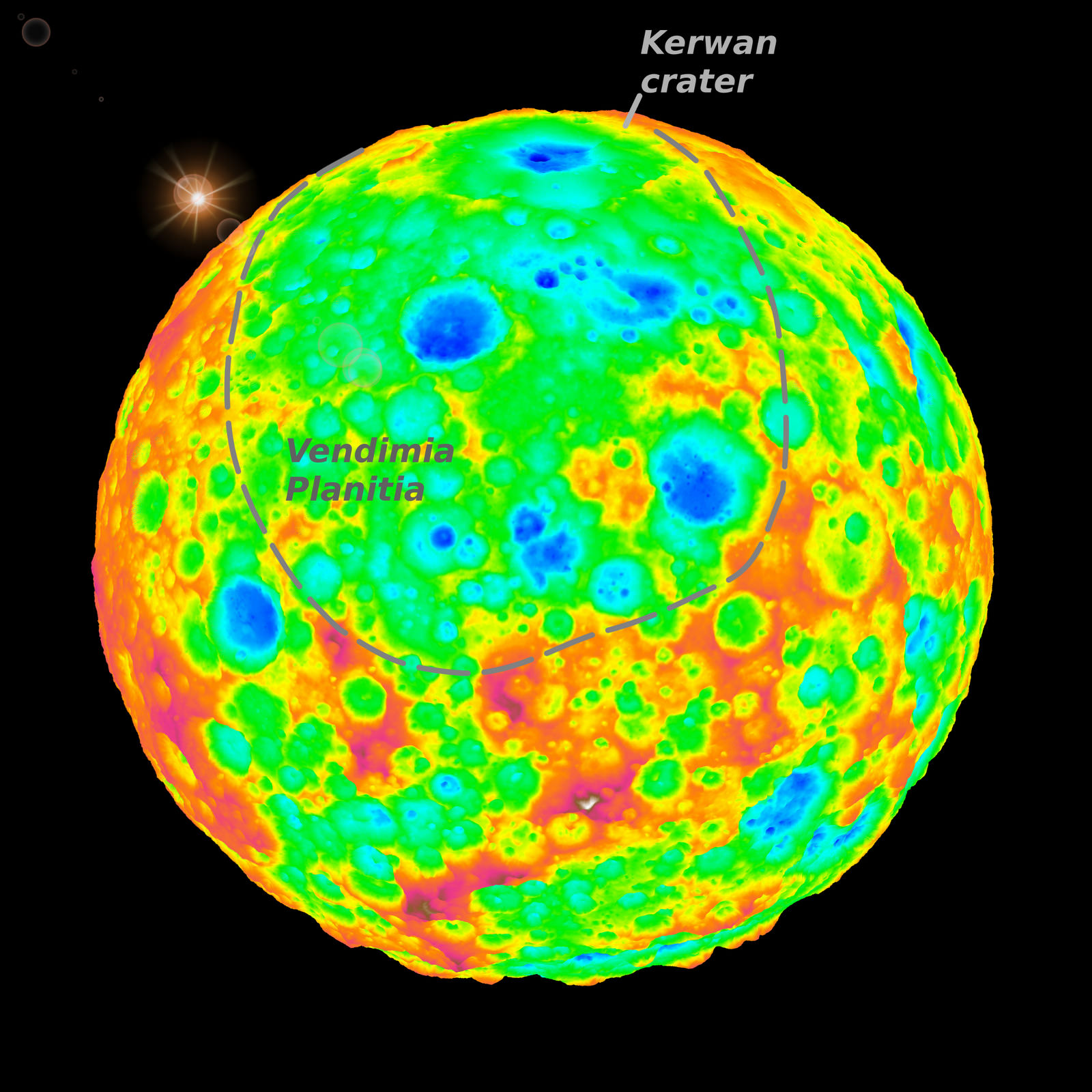Scientists have found a bit of a mystery at the dwarf planet Ceres. Yes, there are those intriguing bright spots inside numerous craters, which is a mystery that has mostly been solved (the bright areas likely made of bright salts leftover from the sublimation of a briny solution of sodium carbonate and ammonium chloride; read more details in this NASA article.)
But a new puzzle involves the craters themselves. In the rough and tumble environment of the asteroid belt, ancient Ceres was certainly pummeled by numerous large asteroids during its 4.5 billion-year lifetime. But yet, there are just a few large craters on Ceres.
How could that be?
“It is as though Ceres cures its own large impact scars and regenerates new surfaces, over and over,” said Dr. Simone Marchi, a senior research scientist at the Southwest Research Institute.

Ceres has lots of little craters, but the Dawn spacecraft, orbiting Ceres since early 2015, has found only 16 craters larger than 100 km, and none larger than 280 km (175 miles) across. Scientists who model asteroid collisions in our Solar System predicted Ceres should have amassed up to 10 to 15 craters larger than 400 kilometers (250 miles) wide, and at least 40 craters larger than 100 km (62 miles) wide.
By comparison, Dawn’s other target of study, the smaller asteroid Vesta, has several large craters, including one 500 kilometers (300 miles) in diameter, covering almost the entire south pole region.
While they aren’t visible now, the scientists say there are clues that large impact basins may be hidden beneath Ceres’ surface.
“We concluded that a significant population of large craters on Ceres has been obliterated beyond recognition over geological time scales, likely the result of Ceres’ peculiar composition and internal evolution,” Marchi said.

There are hints of about three shallow depressions around 800 km (500 miles) wide, and Marchi said they could be what are called or planitiae, or ancient impact basins, left over from large collisions that took place early in Ceres’ history.
There are a few possible reasons why the big craters have been erased, and the scientists now have to figure out which reason or combination of reasons best explain their findings. One reason could be because of large amounts of water or ice in Ceres’ interior, which has long been suspected. Does the absence of large craters lend any insight into Ceres’ water content?
“It might,” Marchi said via email. “There is evidence for ice locally at the surface but it is not clear how much water ice there is in the subsurface.”
Marchi said the craters allow scientists to “probe” down to different depths, depending on their sizes, and that the missing large craters (greater than 100 km in diameter) can provide information on the properties on just the upper 100-200 km or so of Ceres’s outer shell.
Because ice is less dense than rock, the topography could “relax” over time — like what happens if you push on your skin, then take the pressure off, and it relaxes back to its original shape, although this happened extremely more slowly on Ceres. The scientists said that over geological timescales of several million years the water or ice would slowly flow and the craters would smooth out.
Additionally, recent analysis of the center of Ceres’ Occator Crater — where the largest bright areas are located — suggests that the salts found there could be remnants of a frozen ocean under the surface, and that liquid water could have been present in Ceres’ interior.
A recent paper constrains the amount of subsurface ice to be no more than 30-40%.
“However, the lack of large craters cannot be solely explained by the presence of 30-40% of water,” Marchi told Universe Today.
Another reason for the lack of large craters could be hydrothermal activity, such as geysers or cryovolcanoes, which could have flowed across the surface, possibly burying pre-existing large craters. Smaller impacts would have then created new craters on the resurfaced area. Hydrothermal activity has been linked to bright areas on Ceres, as well.
A close look at some of the craters on Ceres show cracked-like surfaces and other areas that looks like there was flow of the surface that “softened” some of the features. Marchi said the team is still working to clarify the Ceres’ peculiar composition and how cryolava or “low viscous material” could have caused the crater rims and bowls to “relax.”

“This is still work in progress,” he told Universe Today. “Ceres is far more richer than Vesta in terms of smooth, flow features. Given that they are in the same environment (e.g. similar impact speed with asteroids), one would think that the production of impact melts would be the same. Thus the fact that we see more flow features on Ceres is a confirmation of its peculiar composition. This may facilitate production of impact “melt” (or ‘mud’ if there is enough water and clays).”
Another reason for the lack of large craters is that smaller, later impacts could have erased the bigger older impact basins. But if that were the case, the older basins would seemingly be more visible than they are now.
But the answer to this puzzle might all come back to the intriguing bright areas on Ceres.
“The presence of ammoniated phyllosilicates, carbonates and salts is truly amazing,” Marchi said. “I think this peculiar composition and Ceres’ internal structure are responsible for the lack of large craters, although we do not know precisely what the obliteration mechanism is.”
Marchi said the large crater obliteration was active well after the late heavy bombardment era, or about 4 billion year ago, so the resurfacing is inextricably linked to Ceres itself and its internal evolution, not impact events.
“All this shows over and over how peculiar Ceres is,” Marchi said. “Beside being a transition object (at inner/outer solar system boundary), it is peculiar in composition, and now also in cratering record.”
Finding out more about Ceres’ interior is one of the more intriguing aspects of Dawn’s continued mission there.
Marchi is lead author of the paper, “The Missing Large Impact Craters on Ceres,” published in the July 26, 2016, issue of Nature Communications.


Just a crazy idea: Would it be possible that ancient large impact traces have been leveled over time by several thousands of smaller impacts?
I mention that in the article, although the authors of the paper don’t talk about it much, except to refer to “protracted widespread resurfacing.”